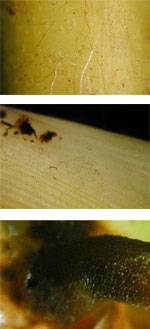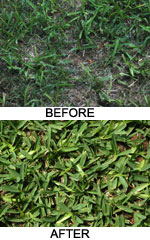Take-All Patch
 Big sections of my St. Augustine lawn started thinning and dying over a 3-year period. It was gradual, and it seemed to be most prominent in the heaviest shade. I just assumed the grass wasn’t getting enough light.
Big sections of my St. Augustine lawn started thinning and dying over a 3-year period. It was gradual, and it seemed to be most prominent in the heaviest shade. I just assumed the grass wasn’t getting enough light.
Late in a fall, however, the problem began to invade areas that received direct sunlight. I knew there must be something else involved. Knowing he had done pioneering research on take-all patch in St. Augustine, I contacted Dr. Phil Colbaugh of the Texas Agricultural Experiment Station. He is a skilled plant pathologist whom I have known for more than 30 years. His work is impeccable, and I knew I needed to revisit his findings on take-all patch. Sure enough, Phil’s descriptions matched up with my turf right down the line. Further, he confirmed the presence of the fungus under a microscope (see his photos of my grass runners).
Phil’s recommendation for take-all patch for the past several years has been to put down a 1/2-inch layer of acidic organic matter, preferably brown Canadian peat moss. Break the peat into small pieces and distribute it evenly over the grass. It is best if you mow the yard first, and you will need to water thoroughly after the peat is spread to settle it to the soil surface. That acidic layer, in contact with the runners, retards development of the fungus and allows the grass to regrow strongly. Take a look at the "before" and "after" photos and you’ll see the incredible difference that happened in just a few weeks of spring growth.
 Two questions Dr. Colbaugh gets frequently (including from me):
Two questions Dr. Colbaugh gets frequently (including from me):
"How often will I need to repeat this process?" He says one treatment of peat will probably remain effective for up to three years.
"Why can’t I use agricultural sulfur, since it develops into sulfuric acid when it becomes wet?" Phil says sulfur is too soluble and is too easily moved by heavy rains. Peat, on the other hand, stays put.
I am a real believer in this treatment. I must admit it sounded too odd to be useful when I first heard it. As much respect as I have for Phil Colbaugh and his research, this one seemed to be over the top. Well, I was wrong, and the results are absolutely astounding. No small coincidence in this guy’s name: Thanks, Dr. Phil, for saving my lawn’s life.
For Dr. Phillip Colbaugh’s complete on-line research report, click here.

